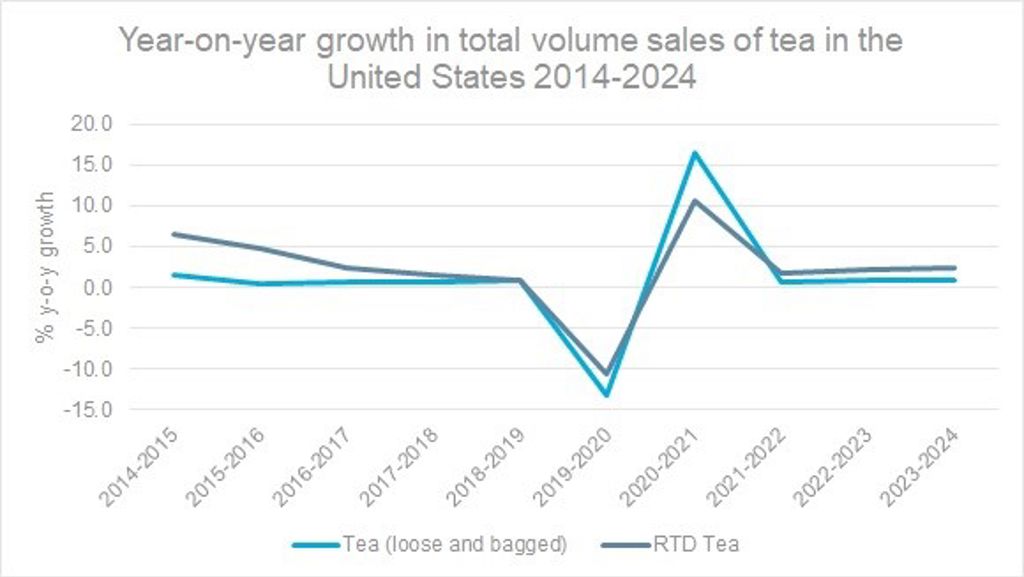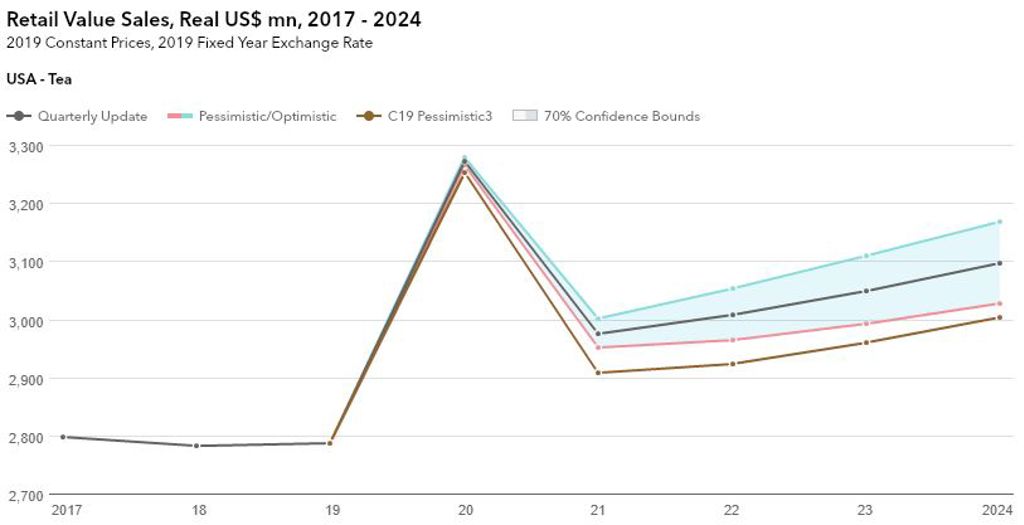The United States faces the largest drop in tea consumption of any Euromonitor-researched market in 2020. Sales of bagged and loose tea are expected to fall 13% and ready-to-drink (RTD) formats are projected to fall 11%. This is a sharp reversal of the recent past, in which tea growth was modest but consistently positive.
Tea in the United States was uniquely vulnerable to Coronavirus (COVID-19) since an unusually high proportion of it is consumed at foodservice. In 2019, that proportion was 48%, compared to 13% in the UK and 6% in Germany. This is primarily because Americans drink iced tea at extremely high rates, often while eating meals outside the home.
The needs of social distancing have posed a major challenge to how tea has traditionally operated in the United States. The pandemic has pushed American tea into two vastly different directions: segments, where most consumption took place outside the home, are struggling as never before, while other teas better-suited for the new normal, such as those with immune support positioning, are experiencing a boom.
Source: Euromonitor International
Foodservice closures are the root cause of tea’s most serious problem
With the virus’s devastating effect on cafes and restaurants, foodservice tea consumption is expected to fall by about 40% in 2020 in the US. This has been somewhat counterbalanced by a 16% rise in retail sales but given that foodservice and retail are nearly perfectly balanced in total consumption this translates to a major decline in net sales.
The decline falls mostly on black tea, as that is what most iced tea in the US is brewed from. Black tea was already struggling prior to COVID-19 as consumers looked towards newer types, especially herbals, and with these foodservice losses, is fair to say that it will take a very long time for black tea consumption to reach pre-COVID-19 levels. Very possibly it never will.
Apart from black tea, the other segments that have suffered the most from COVID-19 are more emergent formats. Bubble tea, heavily reliant on out-of-home consumption, has seen a particularly notable reversal of fortunes, while hard kombucha has struggled to find the White Claw-like success it hoped for at a time when consumers are sticking to tried and true alcoholic beverages. The long-term potential of both remains strong but COVID-19 has significantly disrupted their growth trajectories.
Herbal teas outperform during COVID-19 as consumers seek immune support
The segment that has outperformed the most during COVID-19 is herbal teas. Herbals were already doing well pre-COVID-19, and their strong functional positioning in areas like immune support meant that they benefitted more than other types of tea did when consumers were stockpiling pandemic essentials. Immune support will remain top of mind for a long time for consumers, which should keep herbal tea sales brisk.
The pandemic has also been a tremendous burden on the mental health of Americans, sharpening demand for beverages with calming positioning. Herbal tea is the leader in this area, with ingredients like chamomile and valerian that have been used for centuries for their relaxing properties. Demand for these two functionalities (calming and immune support) will primarily benefit herbals although they will also boost other types like green.
Demand for tea resilient to economic shocks
Another bit of good news is that tea is relatively resistant to economic shocks. Using Euromonitor’s Industry Forecasting Model we can see that historically bagged and loose tea in the US has a 1-year price elasticity of 0.16. That means that for every percentage point the economy contracts from a COVID-19-recession, tea can be reasonably expected to decline by only 0.16% in retail sales terms. In Euromonitor’s most severe pessimistic COVID-19 scenario (C19 Pessimistic3), American real GDP would contract by -9.3% for 2020. Retail sales of tea would decline less than 1% from these direct economic effects.
Of course, were the virus to surge back and trigger such a severe recession the market would be distorted in many other ways, such as new rounds of panic buying and re-closures of restaurants. Retail sales would likely end up sharply increasing in such an event, combined with dramatic losses in foodservice.
The future of US tea: home consumption set to stay
At baseline forecasts, total volumes of bagged and loose tea are expected to regain their 2019 numbers again in 2021. RTD will take another year to do the same.
The volumes may be the same but it will be a very different tea market than it was in 2019. It will be much more oriented towards the home, as a result of long-term shifts in remote working and the financial struggles of many cafes and restaurants. Herbals will represent a much larger share of total consumption than they did before, with calming and immune support functionalities showing especially high rates of interest. Iced tea will be consumed in restaurants again but there will be fewer restaurants in which it can be consumed.
Tea, in general, is set to thrive in the long-term in the United States, although in a different way than it did before COVID-19.


